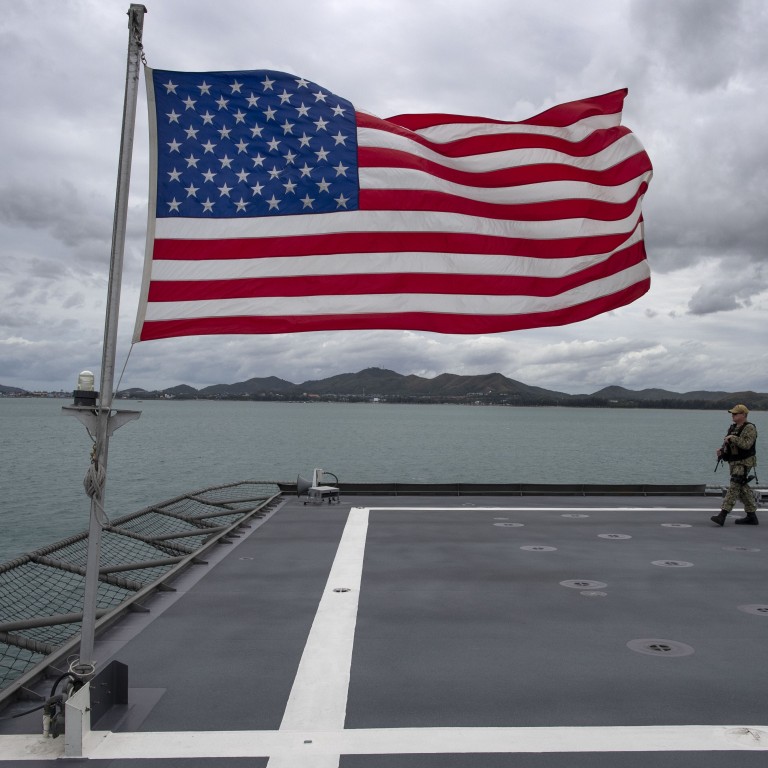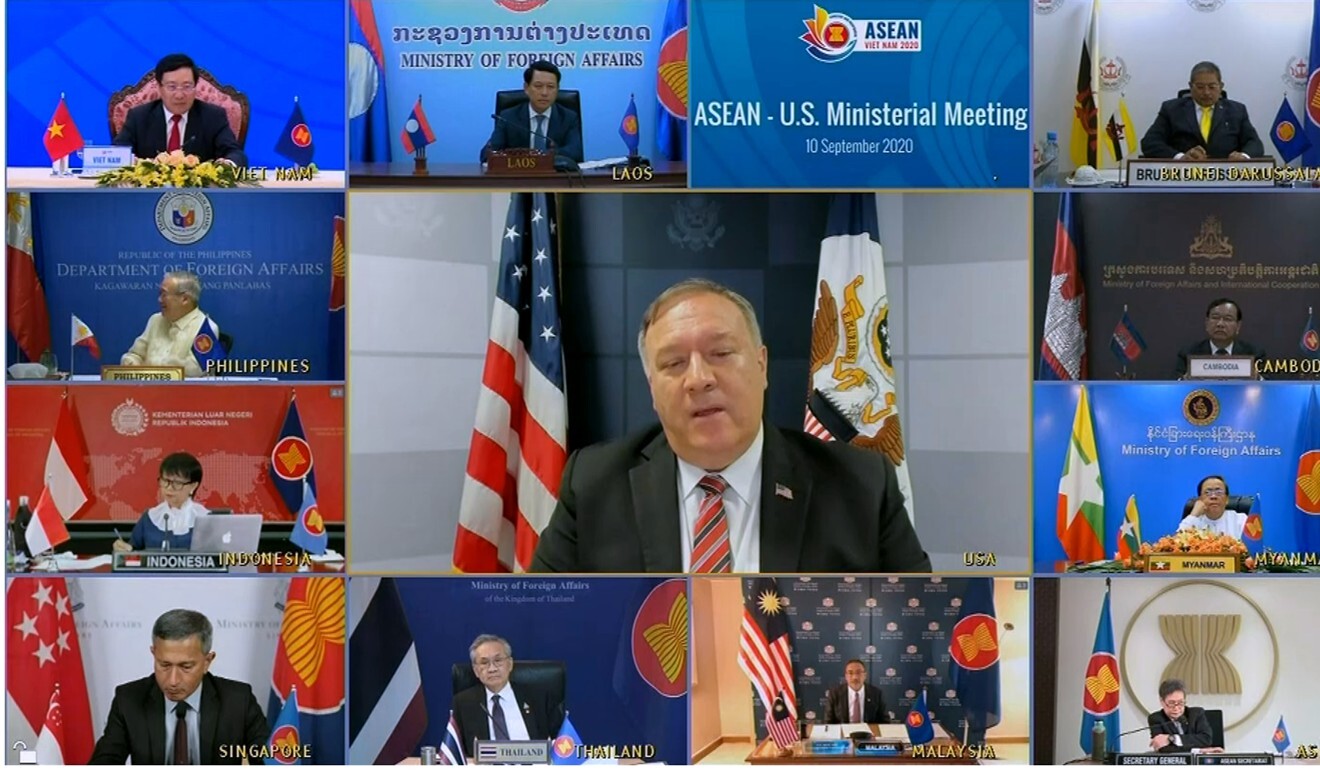
How the US can maintain influence over Asean, whether Trump or Biden wins
- US-China tensions have left Southeast Asian countries in a difficult position, and Washington should offer options instead of forcing them to take sides
- The US could adopt a cooperative approach in pushing against Beijing on issues like the South China Sea, Belt and Road infrastructure and Huawei
Have US-China rivalry and Covid-19 tipped the balance of power in Asia?
The US Defence Department in August said Beijing had “likely considered” Cambodia, Indonesia, Myanmar, Singapore and Thailand for military logistics facilities as it seeks to build a “world-class” military capable of equalling or surpassing that of the US by mid-century.
Yet this confrontational approach towards China has not gained much traction in Southeast Asia, given the regional preference to avoid “making choices” between the two world powers.
Anxieties have been heightened regarding Trump’s transactional approach towards allies and divergences with senior officials in statements about alliances and Washington’s regional presence. America’s use of the stick rather than the carrot to shape China’s choices appears excessively confrontational to many Asia nations. A more serious concern is the dissonance between Trump’s “America First” rhetoric and his country’s calls for stronger alliances and partnerships.
Already, such fears have led to networking attempts between like-minded countries such as Australia, India, Indonesia, Japan, the Philippines, South Korea and Vietnam.
US interests may be better served by not forcing a choice upon Southeast Asian countries but rather offering choices (and reasons) added to US initiatives
Confrontation between China and the US has left Southeast Asian countries in a difficult position. China has in effect demanded that its size and prominence be recognised through “subservience” to its interests. Although many countries have welcomed the Trump administration’s resistance to this assertiveness, they have preferred to voice their support privately lest they attract Beijing’s retaliation, particularly if the US is less capable and less committed to providing its allies with the same security guarantees as in the past.
Immediate concerns might subside if Trump leaves office but doubts about the reliability of US power and presence in the region may persist given Washington’s “diplomatic attention span” and its military capabilities.
Regardless of next week’s result, US interests may be better served by not forcing a choice upon Southeast Asian countries but rather offering choices (and reasons) added to US initiatives.

The US approach of using democracy and ideology to confront China has proven ill-advised. For one, Chinese citizens’ satisfaction with the Communist Party increased between 2003 and 2016. Second, Southeast Asian countries are traditionally leery of the issue of democracy, particularly in light of the “illiberal turn” taken in some Asean states.
Southeast Asians with longer memories remember the US-backed security order was a “bloody business” involving wars, support for communist purges and tolerance of anti-communist autocrats. The US would be wise to capitalise on Southeast Asian countries’ predilection for Washington by accepting the region’s relatively “agnostic approach” to the great powers. Despite their ongoing differences in trade, technology and human rights, China and the US should still be able to find areas of cooperation. Such a move would be a net positive for the region.
The US should seek to accommodate Chinese aspirations within the existing system of rules and norms, while China collaborates with the US and other countries to revise arrangements for the international order. China and the US can find a way to coordinate on issues, such as climate change, nuclear proliferation, and China helping to build infrastructure in the US.
After election, US dialogue with China on Taiwan must resume, analysts say
US Secretary of Defence Mark Esper has advocated a looser, more cooperative approach. Speaking at a seminar in July 2020, Esper called for a network of regional countries to consult diplomatically and “pursue things” to defend the rules-based order.
This is similar to the “principled security network” proposed by his Obama-era predecessor Ash Carter in 2016, which advocates using the complex web of America’s bilateral and multilateral relationships to advance shared values and burden-sharing.
A natural analogue of Esper’s network concept is the emerging Indo-Pacific strategy, which has been endorsed by Australia, India, Japan and the US. The concept seeks to promote the principles of adherence to the rule of law, freedom of navigation and overflight, and no recourse to the use of force. It has already gained some purchase with Asean. But the grouping has been careful not to use any formulation that targets China, directly or indirectly.

Granted, the use of lawfare will do little to change the contours of the South China Sea dispute, but the concerted show of effort could give China some ground for caution if it considers steps which could constitute crossing a “red line”, for example, turning Scarborough Shoal into an artificial island or establishing an Air Defence Identification Zone in the South China Sea.
Explainer: Why are tensions running high in the South China Sea dispute?
Canberra has also rejected China’s claims to the South China Sea. Japan’s recent efforts have centred on Indo-Pacific naval deployments involving its Izumo-class carriers, and exercises with like-minded navies. From April to June 2019, the JS Izumo took part in exercises and interactions with Brunei, Malaysia, Singapore, the Philippines and Vietnam.
The highlight of the JS Izumo’s 2019 deployment involved a four-nation naval exercise, with six ships from Japan, India, the Philippines and the United States, in the South China Sea. The exercise has been interpreted as an overt signal to China.
To compete with China’s scale of financing, the trilateral partners can conceivably raise their allocations to official development assistance, from 0.2 per cent of Gross National Income (GNI), to the OECD average of 0.3 per cent of GNI.
Other options that the US can lay before Southeast Asian countries is a renegotiation of the TPP (or its successor the 11-nation Comprehensive and Progressive Agreement for Trans-Pacific Partnership), which Trump withdrew the US from in 2017. Biden has agreed to renegotiate the pact if he is elected.
US election: what would Trump and Biden foreign policy teams look like?
Whether it is Biden or Trump who wins, Washington should be able to maintain traction in Southeast Asia by laying options on the table for regional countries.

